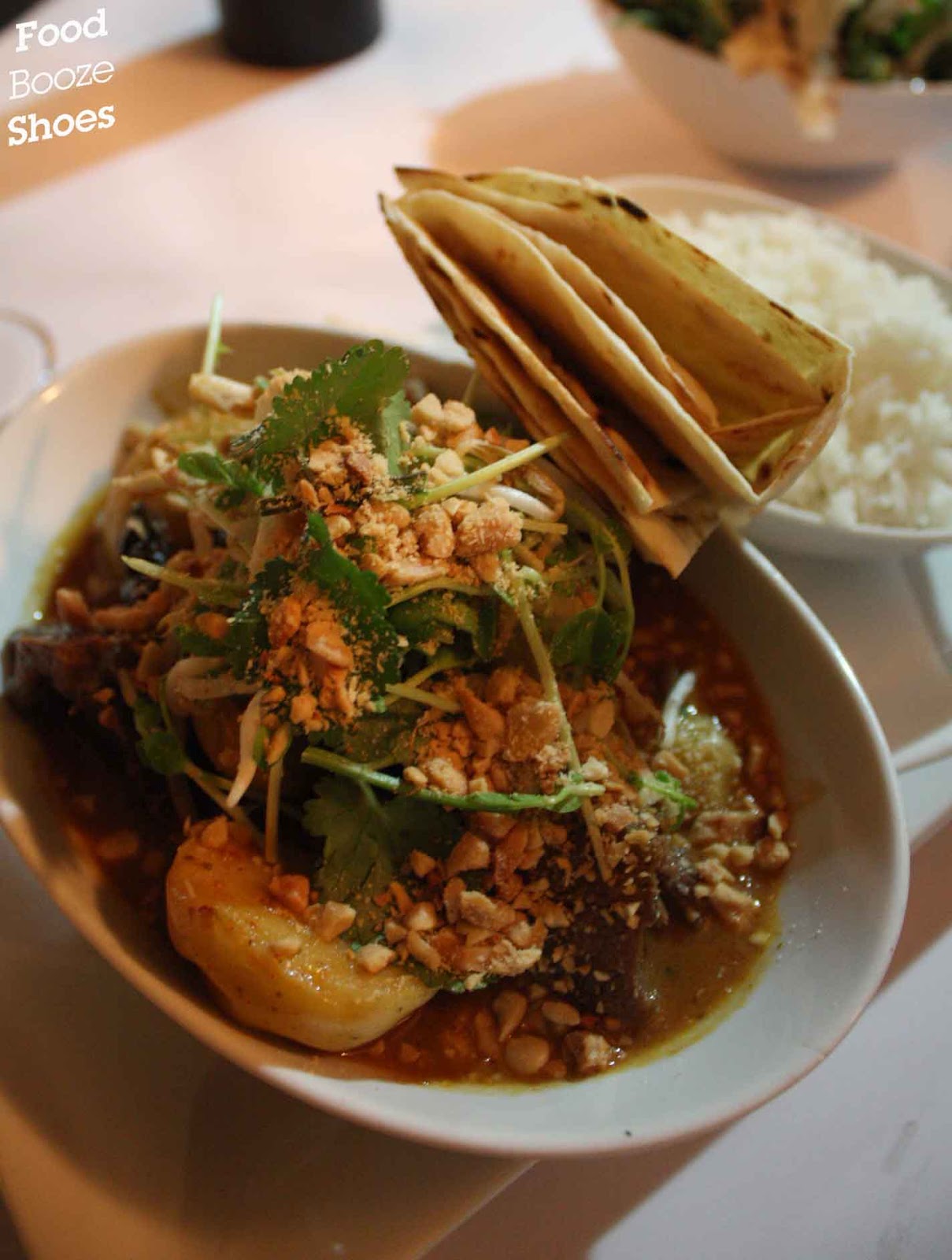 |
| Tapas and Paella class at Extra Virgin Fine Foods, Alexander Street, Crows Nest |
Spanish food is synonymous with tapas, paella and sangria, and as a result, good times and deliciously moreish meals.
While flying off to Spain is a very appealing option, cooking classes in the commercial kitchen at Extra Virgin Fine Foods offers the opportunity to learn to make paella and tapas, as well as tasting your own handiwork.
 |
| Ingredients available for purchase |
The Mediterranean restaurant, just off the buzzy Crows Nest main road, runs 2-hour weekend classes on making paella, which is one of their most popular restaurant menu items.
Owner Mauricio Moreno talks us through the Valencian origins of paella, although all regions of Spain claim it and have their own spin on, arguably, the country's national dish. The first paella was likely a rabbit and snail version from Valencia.
Chef Vincent Giardin runs us through the recipe, which is rather complex but thankfully, a lot of the preparation has been done for the class, with key components, like the veal stock and
sofrito paste, available for purchase from the restaurant or
online.
 |
| Cooking chorizo |
Huddled around the kitchen's island stove, we get started in duos by heating our thin paella pans with olive oil, ready to par-cook the ingredients that will form our paella toppings.
The first is chorizo, that spicy cured pork sausage that Sydney loves as much as pork belly and salt and pepper squid these days.
Extra Virgin Fine Foods uses, and sells, a clever by-product of all their chorizo tapas dishes: oil in which chorizo has been cooked, imparting spicing and pork fat that adds a depth of flavour to a range of dishes, including the paella.
 |
| Cooking prawns |
Prawns, ready peeled for us with the tails left on, are cooked in the same oil until they just lose their surface opaqueness, given all the toppings go back on the heat at the end.
 |
| Cooking squid |
The prepared squid, scored fancily, gets mere moments in the pan, just to pick up some colour.
 |
| Cooking mussels |
Lastly, the mussels which are cooked with a little dry white wine, and covered so they steam until their shells just start to open.
 |
| Semi cooked seafood for paella topping |
The half-cooked toppings are then put aside for later - I don't know how but I managed to not steal a piece or two of chorizo to snack, which would never happen in my home kitchen.
 |
| Extra Virgin Fine Foods' own house-made sofrito paste |
A Spanish
sofrito is not nearly the same as an Italian
soffrito; at least this version isn't. With piquillo peppers, tomato, paprika, saffron and plenty more, this cooked down then blitzed paste forms the fragrant flavour base of the paella but various other dishes too.
 |
| Cooking sofrito in the pan |
Cooking it in the paella pan with all the juices left from cooking the toppings, it smelt gloriously garlicky and full of spices - and you just knew that the
sofrito would be the beginning of something beautiful.
 |
| Mixing the sofrito into the rice |
Bomba or
calasparra are the rices of choice for paella; both short-grained varieties that have different liquid absorption characteristics - but both more absorbent than your standard long grain rice varieties.
Choice of rice is important as it contributes much to the end texture of the paella: fluffy, separate grains are the goal, rather than stodgy or hard.
 |
| Adding stock |
The
bomba rice the restaurant uses takes a ratio of 700 millilitres of stock to 250 grams of rice, and while it can be tempting to stray from that, chef Giardin advises otherwise.
Paella rice is meant to have some bite to it and is ultimately a dry dish, unlike wet and creamy Italian risotto. Indeed, if you're to get the much desired
soccarat crust of crunchy rice on the bottom of the pan, all the liquid needs to be absorbed into the rice.
 |
| Adding paprika |
We used a combination of veal stock and a saffron-infused vegetable stock, although this can vary according to your choice of toppings; for example, fish stock with seafood toppings or chicken stock with chicken and pork.
The spicy, smoked variety of paprika is used for seasoning although you need a fair few pinches to get a spice kick of any sort. We tasted and seasoned with salt and paprika at several points in the cooking process.
 |
| Cooking rice and stock |
The cooking method is vaguely similar to that of risotto, in that you add stock, simmer and let the rice absorb it.
A differing point, or two, is that you can add all the stock in one go (if it fits) and instead of constantly stirring the rice, you leave it be and just push and nudge it every now and then, to ensure the stock is spread around evenly.
This action contributes to the different textures of risotto and paella: the former is creamy as the starches in the rice break down with all the stirring; the latter remains as separate grains that hold themselves as they're not overly disturbed in the cooking process.
 |
| Paella rice and stock going in the oven |
An even heat source is quite important for paella, so a few sessions in a hot oven help with the even cooking process. In our class, the paella goes in the oven twice, returning to the stove after both times.
 |
| Balls of goat's cheese |
As we waited for the rice and stock to do its thing, chef Giardin demonstrated a simple (and popular in the restaurant) tapas that features perfectly rolled balls of soft goat's cheese, caramelised Spanish onion jam (cooked for hours) and
serrano ham that's been crisped in the oven.
 |
| Demonstration of a tapas |
With all the above topping a crisp, toasted bit of bread, the tapas forms quite the tall, artful bite that definitely needs more than one mouthful to conquer.
Everyone in the class gets to make their own with the components that are prepared by the kitchen with so much care.
 |
| Putting toppings on the paella |
When all the stock is added to the pan and the rice is visible above the depths of stock, we're getting close to topping time.
There's a bit of an art to garnishing with the toppings, although there's nothing wrong with just tipping the entire bowl of pre-cooked toppings, and all their juices, on top of the pan of rice.
 |
| Toppings on the paella |
 |
| Chef Vincent Giardin |
Chef Giardin says that you can tell by sound when a paella is ready. That's the point when there is no liquid left in the pan and the heat begins to crisp up the bottom layer of rice for a
soccarat.
Do not stir or push the rice at this point, lest you break the crust, but you can check on it and that it's not burning by lifting the edges with a spatula.
 |
| Garnished with piquillo peppers |
In addition to the chorizo, prawns, squid and mussels, our paellas are garnished with diced piquillo peppers and a touch of chopped fresh parsley.
 |
| Grilling lemons for garnish |
The final flourish is half a lemon, grilled for appearances and juicer, sweeter lemon juice, to be positioned in the centre of the paella. It's a must-have addition for a seafood paella, I think, and adds great colour.
 |
| Goat's cheese, onion jam and serrano ham tapas |
Everyone in the class looks pretty proud of themselves when our paellas are carried out to the dining tables. Sure, there was a lot of help and preparation by the kitchen, but we all had a hand in making our own late lunches and/or early dinners.
The goat's cheese tapas was excellent, with the sweet onion jam partnering well with the very good goat's cheese and crunchy bread and ham components. It's easy to see why its a restaurant favourite.
 |
| Chorizo served with a chimichurri style sauce |
As we relinquished the kitchen back to its rightful masters, Giardin and his sous chef quickly grilled up some chorizo slices for a second tapas dish, served with a red sauce that uses the same base ingredients as a
chimuchurri.
 |
| Paella - ready to eat |
And then it was time to dig into the paella, which bordered on 'too pretty to eat'. The 250 grams of raw rice we used should feed two as a main course alone, while 80 grams of rice per person is recommended if the paella is part of a bigger feast.
 |
| Seafood and chorizo paella |
In the all-important taste test, I'm not just saying it but it was about the best paella I've ever tasted, including all the tourist trap places I sampled in Barcelona.
I have a feeling the chorizo oil and complex
sofrito paste might have had a lot to do with the end result, but also the perfectly cooked squid and mussels, and just cooked grains of rice.
Our paella had a bit of
soccarat in the centre of the dish, which probably means it could have taken a minute or two more on the stove; but nonetheless, two of us almost polished off the entire pan taking seconds, thirds and fourth servings.
 |
| House sangria |
With Extra Virgin Fine Foods' own sangria mix joining the meal, it was pretty much the next best thing to being in sunny Spain - but with the added bonuses of paella to take home and new skills for the kitchen and next dinner party.
Book your class online at
Extra Virgin Fine Foods and see more photos on
my Facebook page.
Food, booze and shoes attended the Tapas and Paella class as a guest of Extra Virgin Fine Foods, with thanks to Helen Lear.























































